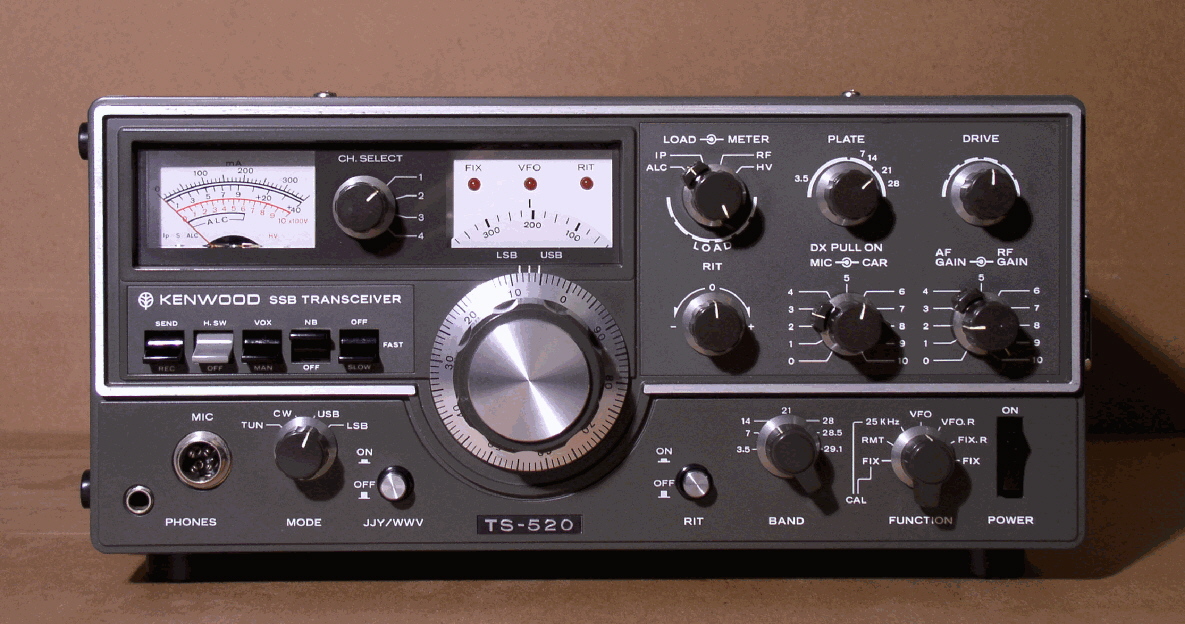K5LAD - 50+ Years of Ham Radio Memories
Volume XLIII
Search keywords: Kenwood transceiver, TS-520, audio processing
Throughout the annals of ham radio
history there have been hundreds of different pieces of equipment to bring joy, and
sometime pain, to the licensed ham radio operator. Among
those hundreds of pieces there have been a select fewer and smaller selection of items
that could be referred to as classics. Those
classics have lingered longer and maintained their popularity for much longer periods of
time. The classic piece tends to hold its
value for much longer, often many years, among the ham population.
One of those classic pieces was the Kenwood TS-520 and it’s
similarly numbered family followers including the TS-520S, TS-520SE, TS-530, and TS-530SP. Kenwood had produced other transceivers but
when the first TS-520 came out, it was a fairly revolutionary concept since it was
primarily all solid-state with the receiver fully transistorized and only 3 tubes in the
transmitter (the driver tube [12BY7] and a pair of final tubes [S2001 – Japanese
version of the 6146]). Incidentally,
the first 520 was introduced to hams in the United States prior to the time that the
Japanese Trio-Kenwood company had set up a sales and service headquarters in the US which
was sometime in the early 70s. Prior to their
US facility, the Kenwood line was imported by the well-known Henry Radio, Inc., in Los
Angeles, Calif. I was one of the first
Kenwood dealers in the US at Derrick Electronics in Broken Arrow, and all my original
Kenwood dealings were with the folks at Henry Radio.
There were numerous reasons that set apart the TS-520 transceiver and
guaranteed their popularity: hybrid
construction with few vacuum tubes, portability, ability to add a CW crystal filter, low
cost, they sounded good on both receive and transmit, they looked good and worked well. The first model even had a module included that
allowed operation on 12 volts DC in addition to the built in 117 volt AC power supply. There were a number of hams who ran the TS-520 as
a mobile rig although by comparison in size with many of the mobile radios today, it was a
mighty big mobile rig.
One of the most interesting “features” of the TS-520 was an
addition to allow modifying the audio in the transmitter section to make the transmitted
signal more “penetrating.” At
that time there were several, usually external, devices, which allowed modifying the
transmitted audio to provide more talk power and make your signal more understandable by
DX stations. There were audio
compressor/expanders to raise the level of audio. There
were more expensive RF and audio compressors that did the same type of task. Now a days, almost every commercial HF
transceiver has a built in audio compressor but back in the 70s, this was not the case.
The TS-520, however, did have a built-in feature that changed the
characteristics of the audio in the speech amplifier.
As I recall, and I did not go back and search the older schematics, turning the
“feature” on changed only a few components and I’m thinking it might have
been just a single resistor or two. Kenwood
made the “feature” available for the user to be able to easily and quickly turn
it on or off from the front panel by adding a push/pull switch on the microphone gain
control potentiometer. Oddly enough, for
some reason, Kenwood labeled the switch “DX pull on” which was actually their
way of saying, “If you want to work DX, pull on this control knob to turn it
on.”
I recently ran across a TS-520 being sold on ebay and it reminded me
of those good ole’ days when the 520 was so popular.
The “DX PULL ON” is located on the right side of the front panel and is
the gray knob just below the PLATE tuning capacitor.
The knob below the PLATE knob had three functions:
the larger outer knob (MIC) provided the user with the ability to raise and lower
the gain in the microphone audio circuit, the smaller inner knob was use to insert carrier
(CAR) for tuning, and the marking above the MIC - CAR is the DX PULL ON, executed by pulling on the
smaller inner knob.

The funny thing was, this panel
message became the way everybody described the actual operation. For instance, any time a ham used the control they
would say something like, “Tell me how I sound when I turn on the DX PULL ON,”
or, “I’m hearing some QRM on your signal on your 520. Why don’t you turn on the DX PULL ON?” That is almost exclusively the way this control
was referred to, in person and on the air.
Later models in the 520-530 changed the markings to call it a
compressor but the die was cast with the first TS-520 and, for many years both during the
time they were sold and afterward, hams referred to that ‘feature’ as the
“DX PULL
ON.” Even today, if
I’m not careful and I’m talking to someone about their TS-520 or one in that
family, I catch myself calling it the term from back in the ‘Good Ole’
Days.’
Page visited 2240 times![]() Return to the Home Page
Return to the Home Page